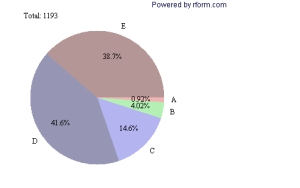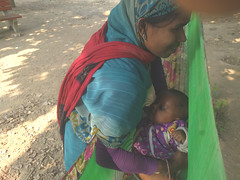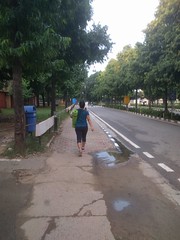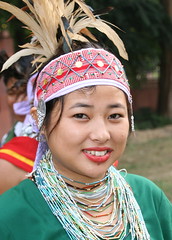SURVEYS
RESULTS AND ANALYSIS FOR THE 2009 ONLINE SURVEY BY THE 50 MILLION MISSING CAMPAIGN
In 2009, the campaign had put up an online survey. The idea was to pin-point the specific elements in the public thinking and perceptions about the female genocide in India, that we needed to focus on as we worked to raise global awareness about this issue.
We circulated the survey via emails and networking sites from December 2008 to May 2009. Some of the responses were offline, as volunteers randomly selected respondents on the ground, specifically people who cannot read and write, and we uploaded their responses into the online form. There were a total of 1201 respondents. However only 1193 completed all the questions and those were the only ones whose responses were used in the final analysis.
ANALYSIS AND DISCUSSION
This is a brief analysis and discussion of the results of the survey. Below that is the data collected and pie charts .
1. Which sections of society are most sensitive to the issue of female gendercide?
Since the survey was online and voluntary (we did not ask anyone to take it; those who wanted to took it on their own initiative), and widely circulated through social networking sites like Facebook, it is assumed that those who chose to participate already had a prior inclination towards gender related issues. Thus the survey indicates that women on average may be more gender sensitive than men. There were 3 women for every 2 men who took the survey. Almost 62% of the respondents were women. As far as the age groups are concerned, the maximum number of respondents were in the age group of 21-40 years. Only about 6% of the respondents were below 21 years. There is also an education correlation, where those with a greater number of higher education degrees seem to show a greater inclination towards gender issues. About 16% of the respondents had college degrees whereas about 77% had university and or professional degrees.
Analysis: Our data seems to indicate the most gender sensitive section of society might be women in the age group 21-40, who also have graduate or professional degrees. This and some of the other questions that we need to specifically address in campaign gendercide awareness focus points are:
1) Are women in fact more sensitive and/ or responsive to the female gendercide issues than men are? 2) And if so why? And what would effectively make men more sensitive and responsive? 3) Why do the younger generations appear to be disinterested in the gendercide issues — the high school and college age generations in particular? Has there been a change in perspective of younger females of themselves in context of violence against women, over the last 2 decades ? Are the gender and violence related experiences of girls in their late teens and women in their early 20s different from that of women in their late 20s, 30s and 40s? Or are teenage girls and younger women simply compromising more? And why is this so? 4) Do higher degrees, say a masters or professional degree make a significant difference to the general perspective and inclination towards gendercide issues — than say a basic Bachelors degree? If so, then why? Is it that individuals with this sensitivity are opting for higher degrees or does the formal education itself contribute something to their perspective?
2. How informed is the public with regards to the female genocide in India?
62% of respondents to the survey estimated that the annual rate of female fetal abortions in India would be 0-10,000 per year, which far less than the actual estimation which is about 1 million a year. In fact it is estimated that that rate may be somewhere in the rage of 2-5 million/ year in India now.
Analysis: This result is interesting in that most of these respondents are already predisposed towards gender issues. Yet despite their general ‘awareness’ they are not aware of the actual situation. In that case we can expect the general public to be far less aware and informed on any or all of the concerned issues. Hence the effort of the campaign should be to inform people of the actual situation. Would the public response change if these issues became better known? How do we separate ignorance from denial in public response, for even when we put out the actual information with research links, we face angry denial from the public? And if there is denial why is it there and how can it be dealt with in an effective manner?
3. How liable are we for the female genocide in choices that we make individually as citizens?
Responding to question 7 of the survey, which said that if the law allowed them to have only 2 children, but also permitted them the use of medical technology to choose the gender of their children, 67% of respondents said they had no gender preference and would happily accept whatever nature bestowed on them. This was to be expected as the participants are already gender sensitive. But what was interesting was that at least 25.52% said they would opt for one girl and one boy. Generally studies show that couples that have had a girl as a first child, would abort the following pregnancies if they continued to conceive girl children, till they conceive a boy. The reverse, that is aborting boy fetuses, to have a girl as a second child, when the first child is a boy is almost unheard of. The public’s assumption is that this is neither discriminatory towards girl children nor a problematic issue at large. However, the gender ratio imbalance in India is caused largely by EXACTLY this choice. There are of course families that are selecting only for sons. However for a majority of the cases the problem is that families are choosing to abort the second and third daughters. The way gender ratio remains balanced in a population, approaching the near 50:50 mark, is only when humans do not meddle with the sex selection process of nature!
Analysis: These are some of the questions we need to test further in how we engage with the public. Do people who select for a boy as second child, when they already have a girl, see themselves as gender impartial? Do they see themselves as playing a collusive role in the targeted elimination of women in India? What emotions are involved here in the individual choices made particularly when there are laws against gender detection through ultrasound and sex selected abortions in India? Guilt? Self-righteousness? Willfulness? Greed? Indifference? And why do people in the west think it is alright for Indians to make this choice, when they themselves are not making this choice or would not, given that the technology is freely available to them too, and there are no laws restricting them. [Note: Countries like the U.K. and Norway of recent observed abnormally skewed gender ratios in their Indian populations, and consequently banned sex-selective abortions in their countries. The laws now apply to the entire populations. In the UK there was a public referendum where more than 70% of the public felt that this pattern of skewed gender ratios was indicative of extreme misogyny and had to be stopped by laws].
4. Are illiteracy and poverty among the underlying causes of female genocide in India?
In response to question 6, which asked where one would observe the greatest annihilation of females in society, about 64% felt that communities where there was more economic hardship, illiteracy or lack or education are the ones that would show the most bias against the girl child. The fact is that it is among the wealthier sectors of society in India — that one observes the largest gender ratio discrepancy. Indeed, it is in the poorest 20% of Indians that the sex ratio is almost ‘normal.’ As education and wealth increases, for each household, or social strata, the rate of annihilation of females, and violence on women increases. The maximum annihilation of females is in the top most 20% of the population. Further more, with girls/women with more number of years of education, the more the chances they will face dowry violence, and be forced through female feticides. [Click here for more]
Analysis: This is the issue we need to intensify our focus on. Why are wealth and education (even of girls and women) driving factors in the female genocide? In other words do the wealthy do it – and the poorer and illiterate not do it – not because one section is more gender sensitive than the other, but only because it is a question of means and facilities. The former has it, the latter does not. Does a woman’s education and wealth, empower not her, but the family and strata she ‘belongs’ to and thus give them more power to inflict violence on females in general? In that case would providing formal education to the poorer sections as well as jobs with decent paychecks only enable an increase in the bias against the girl child in this strata instead of checking it? Being wealthy and educated, of course also means people are aware of the of PNDT laws that prohibit sex selected abortions; dowry laws, homicide laws, and while they do know right from wrong, they also have the knowledge and means to get around these laws. So if education and wealth does not prevent the people from participating in the female genocide, what kind of education would ultimately have an impact on the educated and uneducated to change their bias against girls and women? Is there a proven social method that stops lethal/ genocidal violence against a group of people based on race, religion etc, from elsewhere that we can apply to India? Similarly, are we to assume that with economic betterment we will now see the poorest sections (the bottom most 20% that still has a ‘normal’ gender ratio) also “indulging” to a much larger extent in the practice of female feticide/ infanticide, as well as in dowry and dowry murders?
5. Is men’s self-esteem a factor in female genocide?
64% of respondents said that most men who are violent with their wives have a basic problem with self-esteem, and would continue to abuse their wives irrespective of whatever the situation was, because the abuse was a coping mechanism for the men.
Analysis: The role of men in the female genocide is critical to creating change. So far the emphasis has been on empowering women. But ultimately the change will come not just with change in women’s perception of their own identity and options, (that is Indian women have to learn that their education and wealth is to be used for their independence and freedom, and not to be handed over to the men in their families to use and control), but that of men too. The questions we need to ask further is how does the personal self image of men in society pan out in context of women, as well as in context of other men, and gender relationships. Does the act of violence towards women make men feel more self confident? Less self-confident? How is their self-esteem tied in with the choice of their children’s gender? Are men with sons more secure and confident individuals than men with daughters? How is masculinity defined in a cultural context in India ? Has it changed in any way over time and if so how? How can it be made to change?
6. To what extent is there a sense of social responsibility and collective will in the public at large for change in India’s female genocide?
In the last question, #12, which described a scenario of violent attack on a woman, and asked for audience response, 15% said that they would try to help the victim. However 61% percent said that they may not help but they would remember and discussing it with someone and it would make them very angry.
Analysis: One of the problems of female genocide, what engenders it in India at least, is permissiveness. While 15% say they might help the victim, would the 61% that does not want to get involved but says it will discuss with others, really give it another thought. Or is this a guilt response? Do issues like this come up often in personal and social conversations? Is anger the usual response or passive indifference? What however is interesting is that where they had the option of choosing — indifference etc. 61% of the respondents chose to say they would be angry and would discuss it with someone. What this indicates is the potential for change? Subconsciously the society is aware of the injustice and is also aware of the appropriate response. The challenge for the 50 Million Missing Campaign, now is to evoke that response.
DATA COLLECTED AND PIE CHARTS
1 What is your age group?
A. 20 and below (6.20%)
B. 21-40 (59.50%)
C. 41-60 (27.4%)
D. 60 and above (6.87%)

2 What is your cultural origin?
| A. South Asia (India, Pakistan, Bangladesh, Nepal, Sri Lanka) | 62.01% | |
| B. South-East/ East Asia | 2.09% | |
| C. European [including North America, Australia, New Zealand, Europe] | 30.38% | |
| D. South American | 1.42% | |
| E. Middle Eastern | 0.59% | |
| F. African | 0.50% | |
| G. Other. | 3.01% |

4 What is your religious orientation?
| A. You are very religious, and follow all the rules and rituals of your religion. | 10.8% | |
| B. You have a religion but do not follow all rules and rituals. | 50.71% | |
| C. You do not have a religion but you believe in God or in a Higher power. | 17.5% | |
| D. You are an atheist and don’t have any religion, nor do you believe in God. | 13.31% | |
| E. None of the above. | 7.54% |

5 What is your highest level of education?
| . | A. Illiterate/ no formal education (only for surveys done orally) | 0.25% |
| . | B. High School | 7.04% | |
| . | C. College | 16.23% | |
| . | D. University | 39.33% | |
| . | E. Professional degree, eg. Medicine, Law, Engineering etc. | 37.15% |

6 Indicate your gender.
| A. Male | 38.16% | |
| B. Female | 61.84% |

7 This is a hypothetical situation. The law allows you to have only two children at the most. However, you can use medical techniques to choose what gender you want those two children to be. What would your choice be?
| A. A boy and a girl. | 25.52% | |
| B. Two girls. | 6.11% | |
| C. Two boys. | 1.08% | |
| D. No gender preference. | 67.28% |

8 In certain countries families choose to abort a pregnancy if the ultrasound shows that the fetus is female. How many female fetal abortions do you think take place in a country like India each year? [You don’t have to know this answer. Just take a guess]
| A. None. | 0.92% | |||
| B. Less than 1000 a year. | 4.02% | |||
| C. 1000-2000 a year. | 14.64% | |||
| D. Upto 10,000 a year. | 41.67% | |||
| E. Upto a million a year. | 38.7% |

9 Due to the bias against the girl child, the natural gender ratio in certain countries have become very distorted. In many communities, the total number of boys + men is much higher than that of girls + women. In which sections of the society do you think the gender ratio gap would be largest?
A. Among the poorest and most illiterate. 40.4%
.B. Among the wealthiest. 11.55%
.C. Among the educated and economically comfortable middle-class. 23.35%
.D. Among the educated but struggling middle-class. 24.52%

10 A 25 year old woman is mugged by a stranger, who shoots her dead to steal her purse. In another case, a 25 year old woman is shot and killed by her husband, when her parents refuse to buy a brand new car for him. If you were on the jury for these two cases, how would you judge them?
A. Both Crimes are of same severity. 42.93%
B. Mugging deserves a harsher punishment. 1.34%
C. The domestic crime deserves a harsher punishment. 53.14%
D. None of the above. 2.59%

11. Which of the following best explains the cause of domestic violence where women get beaten and abused by their husbands?
A. The wife provokes the attack by constantly nagging her husband and finding fault with him. 3.77%
B. The husband is a frustrated man of low self esteem and would batter his wife even if she said or did nothing. 62.8%
C. The husband really does not want to hit his wife, but just loses self-control. 5.36%
D. The husband has a drug and/or alcohol abuse problem and that is what causes him to get violent. 14.4%
E. None of the above. 13.5%

12 In a news program on T.V. you see the case of a young woman who was badly disfigured when she was attacked with acid by a man whose advances she had rejected. Her facial features are destroyed, she’s blinded and can barely speak. What kind of an effect would this program have on you?
| A. As bad as it is, you hear about cases like this quite often and most probably, after the program is over, you might not think or speak about this case again. (16.9%)B. It makes you very angry and you think about that poor girl for many days after that, and you discuss it with your friends and people you know. (61.7%)C. It has a big effect on you and you try to seek more information about this girl, and want to see if you can offer help. (15.0%)D. None of the above. (6.28%) |

Credits for the Survey: Chandni Parekh and Rita Banerji designed the questionnaire. Manvendra Bhangui and Lars-Gunnar Svärd downloaded the data and prepared the tables and charts. And Simone Borghesi and Rita Banerji analysed the data.
© The 50 Million Missing Campaign. If citing data please also refer to the campaign website at www. 50millionmissing.info
Please sign the petition below. Just click on the photo. Every signature counts! This campaign needs your support

















When people read the report only then they will realise.
Terrible, horroroso !!
Excellent job ! At least we have now a real view of the problem and this hopefully will enable to find more effective solution. But the survey is only the first step. We need a systematic time-bound plan,with periodical review to tackle the situation.The Govt, NGOs and all the right thinking people need to be involved in the implementation.
Thank you. Here’s our report on the progress of the campaign goals.
This is excellent! Now how can we bring actual change? Spread the word if you collectively plan to bring real change (in action)! Also findings from question 7 is interesting! Somewhat it shows a different trend!
Shame for a well reputable India and for the world if we will continue keeping quite.From this report I understand the magnitude of the problem and I support at 100% this petition. Kindly but firmly request to Indian policy makers to act. Protect a woman multiply the world.